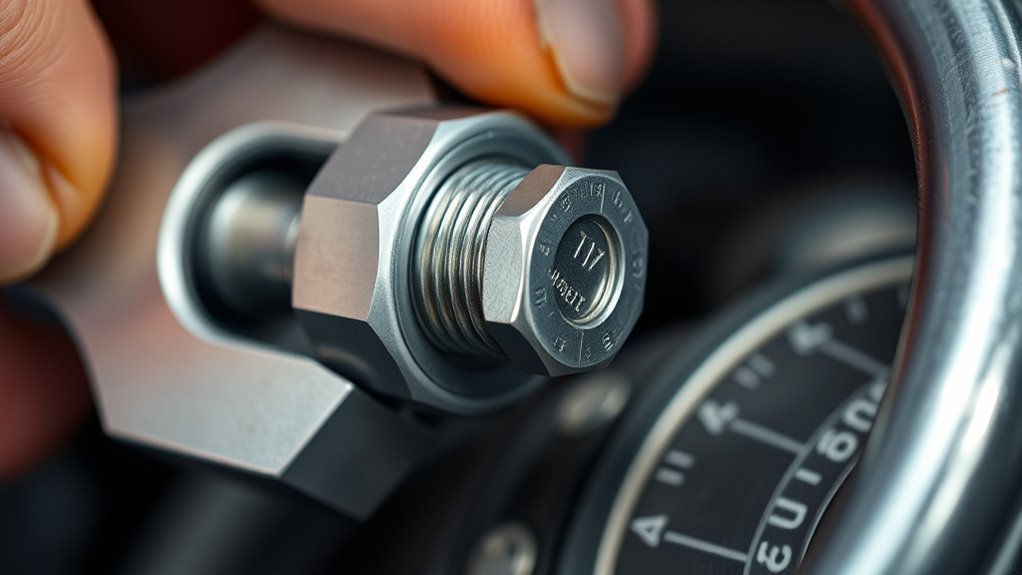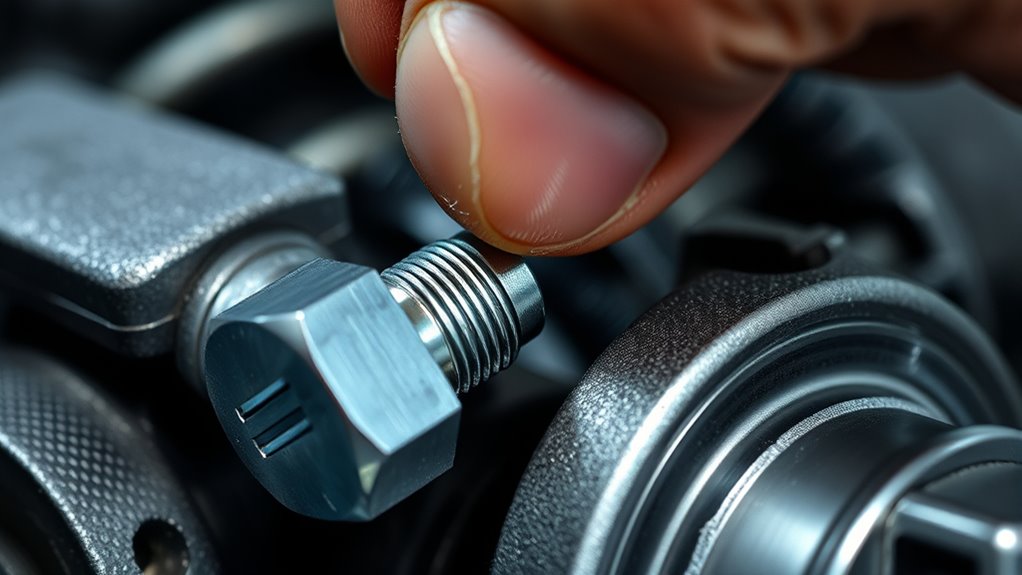Torque-to-yield bolts are designed to stretch beyond their elastic limit during installation, which ensures a precise, consistent clamping force. Unlike standard bolts, they are made from high-strength materials that deform plastically, maintaining tension over time even under stress. To install them properly, you must follow specific torque and angle sequences without over-tightening, or you risk failure. Want to understand the detailed process and why these bolts are essential? Keep exploring to learn more.
Key Takeaways
- Torque-to-yield bolts are high-strength fasteners designed to stretch plastically beyond their elastic limit during installation.
- They rely on controlled plastic deformation to maintain a consistent clamping force over time.
- Proper installation involves applying a precise torque and additional angle tightening to ensure correct stretch.
- Over-tightening can cause bolt failure by exceeding the yield point, while under-tightening reduces clamping effectiveness.
- Material properties like ductility and tensile strength are crucial for the bolt’s ability to handle permanent deformation.

Torque-to-yield bolts are specialized fasteners designed to provide a precise clamping force by stretching beyond their elastic limit during tightening. Unlike traditional bolts, which are tightened to a specified torque and rely on elastic deformation, these bolts are designed to be stretched plastically, ensuring a consistent and reliable clamping force. Understanding the material properties of these bolts is essential, as they are typically made from high-strength alloys that can handle the permanent deformation without compromising integrity. The unique behavior of these materials allows the bolt to maintain tension over time, even under thermal or mechanical stresses, making them ideal for applications where safety and precision are paramount.
Torque-to-yield bolts rely on high-strength alloys to maintain tension through permanent deformation.
When working with torque-to-yield bolts, you must pay close attention to the installation procedures. Because these bolts are intentionally stretched beyond their elastic limit, the process differs from standard bolt tightening. First, you need to clean and inspect the bolt and the mating surfaces to guarantee proper engagement and prevent any debris from affecting the torque reading. Next, you should follow the manufacturer’s recommended torque specifications carefully, using a calibrated torque wrench to apply the initial tightening torque. This step is critical because applying the correct torque ensures the bolt reaches the yield point without over-tightening, which could damage the bolt or compromise its performance.
After reaching the initial torque, you typically need to tighten the bolt an additional fraction of a turn, often called “angle tightening,” to achieve the proper stretch. This step requires precision, as overtightening can cause the bolt to exceed its yield point excessively, increasing the risk of sudden failure, while under-tightening might lead to insufficient clamping force. It’s essential to follow the specified tightening angles and sequences provided by the manufacturer, especially when multiple bolts are involved, to guarantee even load distribution.
In addition, proper installation procedures include rechecking torque after the initial tightening, if recommended, to account for any settling or relaxation of the material. Use consistent, calibrated tools throughout the process to maintain accuracy. Remember that material properties such as ductility, tensile strength, and yield strength directly influence how the bolt behaves during installation. These properties determine the amount of stretch the bolt can withstand without fracturing, making adherence to proper procedures indispensable for safety and longevity. Furthermore, understanding the regional usage of torque-to-yield bolts can help select appropriate fasteners for specific environments or applications, ensuring optimal performance. By understanding the material properties and following the correct installation procedures, you guarantee that torque-to-yield bolts perform reliably, providing the necessary clamping force over their service life.
Frequently Asked Questions
Can Torque-To-Yield Bolts Be Reused Safely?
You shouldn’t reuse torque-to-yield bolts safely because their material properties change after the first use. These bolts stretch during installation, which weakens their reusability and raises reusability concerns. Reusing them can lead to improper clamping force, potential failure, or engine damage. Always replace torque-to-yield bolts with new ones to guarantee safety, reliability, and peak performance, rather than risking the integrity of your assembly.
What Tools Are Necessary for Installing Torque-To-Yield Bolts?
To install torque-to-yield bolts correctly, you need a torque wrench that meets the specified torque settings, ensuring proper fastening techniques. You may also require a angle gauge for precise tightening beyond initial torque, and lubrication as per torque specifications. Using these tools helps you achieve accurate torque specifications, preventing over-tightening or under-tightening, which is essential for the safety and reliability of the assembly.
How Do Temperature Changes Affect Torque-To-Yield Bolts?
Temperature changes directly impact torque-to-yield bolts through thermal expansion, affecting their tension and clamping force. When temperatures rise, the bolt’s material properties change, causing it to expand and potentially loosen the joint. Conversely, cooling contracts the bolt, increasing tension and risk of over-tightening. You should consider these effects when tightening, ensuring proper torque application to account for thermal expansion and maintain reliable joint integrity.
Are Torque-To-Yield Bolts Suitable for All Engine Types?
Torque-to-yield bolts aren’t suitable for all engine types because material compatibility and installation procedures vary. You need to make certain these bolts match your engine’s materials; otherwise, they could fail. Follow the manufacturer’s installation procedures precisely. For some engines, traditional bolts work better, especially if the materials aren’t compatible or if the torque-to-yield process risks damaging components. Always consult your engine’s specifications before choosing these bolts.
What Are the Signs of Bolt Failure in Torque-To-Yield Applications?
You notice stress indicators like persistent leaks or unusual vibrations, and failure symptoms such as cracked threads or loosened bolts. These signs signal your torque-to-yield bolts might be failing, risking engine damage. Keep an eye out for uneven torque readings, visible corrosion, or bolt deformation, as these are clear visual cues. Addressing these early helps prevent catastrophic engine failure and guarantees your vehicle runs smoothly and safely.
Conclusion
So, next time you tighten those torque-to-yield bolts, remember that the right approach isn’t just about following numbers—it’s about understanding the process. Sometimes, a little coincidence happens when everything lines up perfectly, ensuring a secure fit without over-tightening. It’s like a small reminder that paying attention to detail really does make a difference. After all, a well-installed bolt isn’t just luck; it’s knowing when to stop and trust the process.









